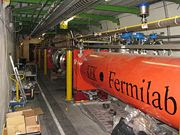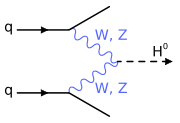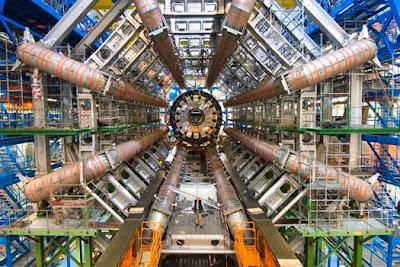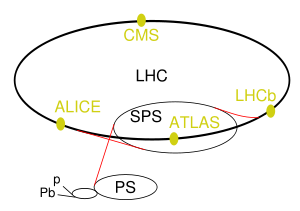(LHC) is the world's largest particle accelerator complex, intended to collide opposing beams of 7 TeV protons. Its main purpose is to explore the validity and limitations of the Standard Model, the current theoretical picture for particle physics. The LHC was built by the European Organization for Nuclear Research (CERN), and lies underneath the Franco-Swiss border near Geneva, Switzerland.
The LHC is the world's largest and the highest-energy particle accelerator. It is funded by and built in collaboration with over eight thousand physicists from over eighty-five countries as well as hundreds of universities and laboratories.
The LHC is now operational, and in the process of being prepared for first collisions. The first beam was circulated through the collider on the morning of September 10th, 2008. The first high-energy collisions are planned to take place after the LHC is officially unveiled on 21 October 2008.
When activated, it is theorized that the collider will produce the elusive Higgs boson, the observation of which could confirm the predictions and missing links in the Standard Model of physics and could explain how other elementary particles acquire properties such as mass.
Although a few individuals have questioned the safety of the planned experiments in the media and through the courts, the consensus in the scientific community is that there is no basis for any conceivable threat from the LHC particle collisions.
The LHC is the world's largest and highest-energy particle accelerator. The collider is contained in a circular tunnel with a circumference of 27 kilometres (17 mi) at a depth ranging from 50 to 175 metres underground. The 3.8 metre (150 inches) diameter, concrete-lined tunnel, constructed between 1983 and 1988, was formerly used to house the LEP, an electron-positron collider. It crosses the border between Switzerland and France at four points, although most of it is in France. Surface buildings hold ancillary equipment such as compressors, ventilation equipment, control electronics and refrigeration plants.
The collider tunnel contains two adjacent beam pipes, each containing a proton beam (a proton is one type of hadron). The two beams travel in opposite directions around the ring. Some 1,232 bending magnets keep the beams on their circular path, while an additional 392 focusing magnets are used to keep the beams focused, in order to maximize the chances of interaction between the particles in the four intersection points, where the two beams will cross. In total, over 1,600 superconducting magnets are installed, with most weighing over 27 tonnes. Approximately 96 tonnes of liquid helium is needed to keep the magnets at the operating temperature (1.9K), making the LHC the largest cryogenic facility in the world at liquid helium temperature.
Once or twice a day, as the protons are accelerated from 450 GeV to 7 TeV, the field of the superconducting bending magnets will be increased from 0.54 T to 8.3 T.

The protons will each have an energy of 7 TeV, giving a total collision energy of 14 TeV. At this energy the protons have a gamma factor of about 7,500 and move at about 99.999999% of light speed. It will take less than 90 microseconds for a proton to travel once around the main ring (a speed of about 11,000 revolutions per second). Rather than continuous beams, the protons will be bunched together, into 2,808 bunches, so that interactions between the two beams will take place at discrete intervals never shorter than 25 ns apart. When the collider is first commissioned, it will be operated with fewer bunches, to give a bunch crossing interval of 75 ns. The number of bunches will later be increased to give a final bunch crossing interval of 25 ns.
Prior to being injected into the main accelerator, the particles are prepared by a series of systems that successively increase their energy. The first system is the linear accelerator Linac 2 generating 50 MeV protons, which feeds the Proton Synchrotron Booster (PSB). There the protons are accelerated to 1.4 GeV and injected into the Proton Synchrotron (PS), where they are accelerated to 26 GeV. Finally the Super Proton Synchrotron (SPS) is used to increase their energy to 450 GeV before they are at last injected (over a period of 20 minutes) into the main ring, where proton bunches are accumulated, accelerated (over a period of 20 minutes) to their peak 7 TeV energy, and finally stored for many hours (10 to 24) while collisions occur at the four intersection points.
The LHC will also be used to collide lead (Pb) nuclei with a collision energy of 1,150 TeV. The Pb ions will be first accelerated by the linear accelerator Linac 3, and the Low-Energy Injector Ring (LEIR) will be used as an ion storage and cooler unit. The ions then will be further accelerated by the Proton Synchrotron (PS) and Super Proton Synchrotron (SPS) before being injected into LHC ring, where they will reach an energy of 2.76 TeV per nucleon.
Six detectors are being constructed at the LHC, located underground in large caverns excavated at the LHC's intersection points. Two of them, the ATLAS experiment and the Compact Muon Solenoid (CMS), are large, general purpose particle detectors. A Large Ion Collider Experiment (ALICE) is designed to study the properties of quark-gluon plasma from the debris of heavy-ion collisions. The other three, (LHCb, TOTEM, and LHCf), are smaller and more specialized.
PurposeWhen activated, it is theorized that the collider will produce the elusive Higgs boson. The verification of the existence of the Higgs boson would be a significant step in the search for a Grand Unified Theory, which seeks to unify three of the four known fundamental forces: electromagnetism, the strong nuclear force and the weak nuclear force, leaving out only gravity. The Higgs boson may also help to explain why gravitation is so weak compared with the other three forces. In addition to the Higgs boson, other theorized particles, models and states might be produced, and for some searches are planned, including supersymmetric particles, compositeness (technicolor), extra dimensions, strangelets, micro black holes and magnetic monopoles.
Research
When in operation, about seven thousand scientists from eighty countries will have access to the LHC. Physicists hope to use the collider to test various grand unified theories and enhance their ability to answer the following questions:
Is the popular Higgs mechanism for generating elementary particle masses in the Standard Model realised in nature? If so, how many Higgs bosons are there, and what are their masses?
Will the more precise measurements of the masses of the quarks continue to be mutually consistent within the Standard Model?
Do particles have supersymmetric ("SUSY") partners?
Why are there apparent violations of the symmetry between matter and antimatter? See also CP-violation.
Are there extra dimensions indicated by theoretical gravitons, as predicted by various models inspired by string theory, and can we "see" them?
What is the nature of dark matter and dark energy?
Why is gravity so many orders of magnitude weaker than the other three fundamental forces?
Is time travel (utilising either General theory of relativity or wormholes or black holes) possible?
Renowned British astrophysicist Stephen Hawking has bet £50 the mega-experiment will not find the elusive particle seen as the holy grail of cosmic science. "I think it will be much more exciting if we don't find the Higgs. That will show something is wrong, and we need to think again. I have a bet of 100 dollars that we won't find the Higgs," said Prof Hawking.[26]
Prof Hawking said the experiment could discover superpartners, particles that would be "supersymmetric partners" to particles already known about. "Their existence would be a key confirmation of string theory, and they could make up the mysterious dark matter that holds galaxies together," he said on the BBC. "Whatever the LHC finds, or fails to find, the results will tell us a lot about the structure of the universe," he said.
As an ion collider
The LHC physics program is mainly based on proton-proton collisions. However, shorter running periods, typically one month per year, with heavy-ion collisions are included in the programme. While lighter ions are considered as well, the baseline scheme deals with lead ions. This will allow an advancement in the experimental programme currently in progress at the Relativistic Heavy Ion Collider (RHIC).
Proposed upgrade
After some years of running, any particle physics experiment typically begins to suffer from diminishing returns; each additional year of operation discovers less than the year before. The way around the diminishing returns is to upgrade the experiment, either in energy or in luminosity. A luminosity upgrade of the LHC, called the Super LHC, has been proposed,[28] to be made after ten years of LHC operation. The optimal path for the LHC luminosity upgrade includes an increase in the beam current (i.e., the number of protons in the beams) and the modification of the two high luminosity interaction regions, ATLAS and CMS. To achieve these increases, the energy of the beams at the point that they are injected into the (Super) LHC should also be increased to 1 TeV. This will require an upgrade of the full pre-injector system, the needed changes in the Super Proton Synchrotron being the most expensive.
CostThe total cost of the project is anticipated to be between €3.2 to €6.4 billion.[6] The construction of LHC was approved in 1995 with a budget of 2.6 billion Swiss francs (€1.6 billion), with another 210 million francs (€140 million) towards the cost of the experiments. However, cost over-runs, estimated in a major review in 2001 at around 480 million francs (€300 million) for the accelerator, and 50 million francs (€30 million) for the experiments, along with a reduction in CERN's budget, pushed the completion date from 2005 to April 2007.[29] 180 million francs (€120 million) of the cost increase have been due to the superconducting magnets. There were also engineering difficulties encountered while building the underground cavern for the Compact Muon Solenoid. In part this was due to faulty parts lent to CERN by fellow laboratories Argonne National Laboratory or Fermilab.
Computing resourcesThe LHC Computing Grid is being constructed to handle the massive amounts of data produced by the Large Hadron Collider. It incorporates both private fibre optic cable links and existing high-speed portions of the public Internet, to get data from CERN to academic institutions around the world.
The distributed computing project
LHC@home was started to support the construction and calibration of the
LHC. The project uses the BOINC platform to simulate how particles will travel in the tunnel. With this information, the scientists will be able to determine how the magnets should be calibrated to gain the most stable "orbit" of the beams in the ring.

Related posts:
Source: en.wikipedia.org
 Name: Amara
Name: Amara


























 Nama:
Nama: 
















 The protons will each have an energy of 7 TeV, giving a total collision energy of 14 TeV. At this energy the protons have a gamma factor of about 7,500 and move at about 99.999999% of light speed. It will take less than 90 microseconds for a proton to travel once around the main ring (a speed of about 11,000 revolutions per second). Rather than continuous beams, the protons will be bunched together, into 2,808 bunches, so that interactions between the two beams will take place at discrete intervals never shorter than 25 ns apart. When the collider is first commissioned, it will be operated with fewer bunches, to give a bunch crossing interval of 75 ns. The number of bunches will later be increased to give a final bunch crossing interval of 25 ns.
The protons will each have an energy of 7 TeV, giving a total collision energy of 14 TeV. At this energy the protons have a gamma factor of about 7,500 and move at about 99.999999% of light speed. It will take less than 90 microseconds for a proton to travel once around the main ring (a speed of about 11,000 revolutions per second). Rather than continuous beams, the protons will be bunched together, into 2,808 bunches, so that interactions between the two beams will take place at discrete intervals never shorter than 25 ns apart. When the collider is first commissioned, it will be operated with fewer bunches, to give a bunch crossing interval of 75 ns. The number of bunches will later be increased to give a final bunch crossing interval of 25 ns. When in operation, about seven thousand scientists from eighty countries will have access to the LHC. Physicists hope to use the collider to test various grand unified theories and enhance their ability to answer the following questions:
When in operation, about seven thousand scientists from eighty countries will have access to the LHC. Physicists hope to use the collider to test various grand unified theories and enhance their ability to answer the following questions: After some years of running, any particle physics experiment typically begins to suffer from diminishing returns; each additional year of operation discovers less than the year before. The way around the diminishing returns is to upgrade the experiment, either in energy or in luminosity. A luminosity upgrade of the LHC, called the Super LHC, has been proposed,[28] to be made after ten years of LHC operation. The optimal path for the LHC luminosity upgrade includes an increase in the beam current (i.e., the number of protons in the beams) and the modification of the two high luminosity interaction regions, ATLAS and CMS. To achieve these increases, the energy of the beams at the point that they are injected into the (Super) LHC should also be increased to 1 TeV. This will require an upgrade of the full pre-injector system, the needed changes in the Super Proton Synchrotron being the most expensive.
After some years of running, any particle physics experiment typically begins to suffer from diminishing returns; each additional year of operation discovers less than the year before. The way around the diminishing returns is to upgrade the experiment, either in energy or in luminosity. A luminosity upgrade of the LHC, called the Super LHC, has been proposed,[28] to be made after ten years of LHC operation. The optimal path for the LHC luminosity upgrade includes an increase in the beam current (i.e., the number of protons in the beams) and the modification of the two high luminosity interaction regions, ATLAS and CMS. To achieve these increases, the energy of the beams at the point that they are injected into the (Super) LHC should also be increased to 1 TeV. This will require an upgrade of the full pre-injector system, the needed changes in the Super Proton Synchrotron being the most expensive.



















